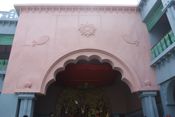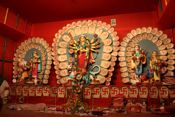Jagari Shangha
The Jagari Shangha was a very interesting pandal. Rather than trying to build the biggest or most opulent pandal, they built an extremely theme focused pandal on a narrow theme: Mangoes. The pandal was decorated with mangoes everywhere. I couldn't decide whether the mangoes were real, or wood/plastic reproductions, but all decorations consisted of mangoes or mango-related decorations. They had people carrying mangoes, mango trees, baskets of mangoes, mango-shaped doorways, and more. Outside the pandal they had a mini-encyclopedia listing of all the countries which grow mangoes, and how much they grow, along with other mango-facts. It was quite interesting (I had no idea that mangoes grow in the US), and very well done. The idol continued this theme, with Durga and the other idols presented in front of a mango forest and with giant mangoes behind them. There was a rumor that the idol for this pandal was actually made from mangoes, but I rather doubt it.
Prize: Most focused theme.
 |  |  |
Kalitala Sporting Club
When we first arrived at the Kalitala Sporting Club pandal, I kept asking my wife where the pandal was -- I literally couldn't find it, even though it was right in front of me. It turns out that the Kalitala Sporting Club pandal was built to resemble a house, which means that it blended in with the neighborhood seamlessly. After days of seeing castles, temples, and even a boat for a pandal, finding one that looked like something as mundane as a house was quite the change. There were stairs (made from styrofoam -- don't take them), walls, balconies, and even doors, completely made from styrofoam. Outside, they had an area dedicated to Tagore's childhood home, complete with a statue. They also had a small area full of blossoming Kashful, which is a grass that's heavily associated with the Durga Pujo. The idol was nice, but it was hard to get to through the crowd -- we had arrived during one of the religious ceremonies, so the entire neighborhood was present. All in all, a tastefully understated pandal.
Prize: Most well-integrated pandal.
 |  |  |
Bosepukur Sitala
Bosepukur Sitala was located a short-ish drive from the Kalitala Sporting Club pandal, but we had to walk forever to get there, due to road closures and heavy crowding. The Bosepukur Sitala had a very novel theme: Astrological signs. Along the walls, they had several symbols for the various traditional signs, along with the western and bengali symbols associated with the various signs. Much of the artwork in this pandal was based on the zodiac circle, which recurred many times inside the pandal as well as outside on an enormous statue. The idol was rather nice, in an understated manner. Unlike the opulent pandals we saw on Shoptomi, this one was rather normal in tone and had a nice symmetry. Also, it was normal sized and not twenty feet tall, like the idols at Ekdalia Evergreen and Shinghi Park.
Prize: Most geometric artwork.
 |  |  |
Salt Lake HA Block
The Salt Lake HA Block pandal was heavily focused on basket-work. They had statues and chandeliers built from baskets, as well as decorations built from flat woven wicker, just like a basket. The outside of the pandal was built from the same materials, which was quite nice. Unfortunately, I was unable to get good pictures in the pandal, due to the difficult lighting conditions. I only had a handful that worked out. I loved the chandelier in this pandal -- the way the lights are occluded by the weaves of the baskets, and barely leak out, was incredible. My picture of this chandelier is one of my favorites from the entire pujo. I also liked the matte look of the idol, and the way the decorations matched the look.
Prize: Most photogenic chandelier.
 |  |  |
Salt Lake HB Block
The Salt Lake HB Block pandal was very cool. Most the artwork in the HB block pandal was created from what appeared to be crushed glass bangles, which gave everything a very circular, brush-like appearance. Even the chandelier was created with this material, with hanging bangles acting (rather poorly) as light shades. A few pieces of art were painted, however, rather than made with this material, although even these had frames and other accents created from it. I can only imagine the number of glass bangles they went through to make this pandal. It was difficult to get a close look at the idol in this pandal, since we again arrived during a ceremony (this one involving a lot of drums), but it looks like the idol had very similar decorations.
Prize: Best glasswork.
 |  |  |
Salt Lake AB Block
The Salt Lake AB Block pandal had a very organic feel to it. Rather than relying on paintings, opulent artwork or other staples of large pandals, the pandal was decorated with hand-painted and (apparently) hand-thrown ceramics. These were arranged along the walls, and the path through the pandal allowed you to get very close to the decorations. The idol room featured an incredible chandelier, too, made from coconuts with holes poked in them. Interspersed through these coconuts were a variety of palm leaves. This produced a rather nice diffuse lighting throughout the room, making for good pictures of the gorgeous idol. The idol was my favorite part of this pandal, with very life-like, realistic painting (Durga, Saraswati and Lakshmi all have believable facial expressions!), and I loved the decorations around the idol. Quite nice.
Prize: Most photogenic idol.
 |  |  |
Salt Lake GB Block
The Salt Lake GB Block is at a disadvantage in this review. The design elements of this pandal were very similar to those in the HA block pandal, complete with basket people and wicker design elements. If I had seen these two pandals in a different order, I'd probably feel much more inclined towards GB than HA. As it was, the GB block pandal seemed to be similar to the HA block pandal in all ways except for the idol. The GB block idol, rather than featuring wicker decorations around the gods, instead featured an earthenware, painted idol. The idol was very nice looking, although it did not completely match the rest of the pandal. I rather liked the flower decorations.
Prize: Most incongruous idol.
 |  |  |
Telengabagan
The Telengabagan pandal was a very different design than the other pandals I've seen. While almost all pujo pandals have different entrances and exits, Telengabagan was the only one we visited that was arranged in a circular manner rather than a rectangular. Most pandals have a large, open room, with the idol in one side and the entrance and exits on other sides. Telengabagan was completely circular. The idol was in the center, and there was a walkway around the edges. They actually had security guards literally pushing people through the pandal to get them to stop lingering (which made it very, very tricky to get pictures -- sometimes being able to feign a language barrier is useful). The idol at Telengabagan was also very different from other pandals; here, the idol was not clothed (although draped in a sheet), and the other idols were arranged in a circular manner. I'm not sure if the decorations are supposed to match any specific temples or art type, but the motif looked very south indian. The ceiling of the pandal was covered in reflective panels; if you look carefully, you may be able to find me in there.
Prize: Most post-modern.
 |  |  |
No comments:
Post a Comment